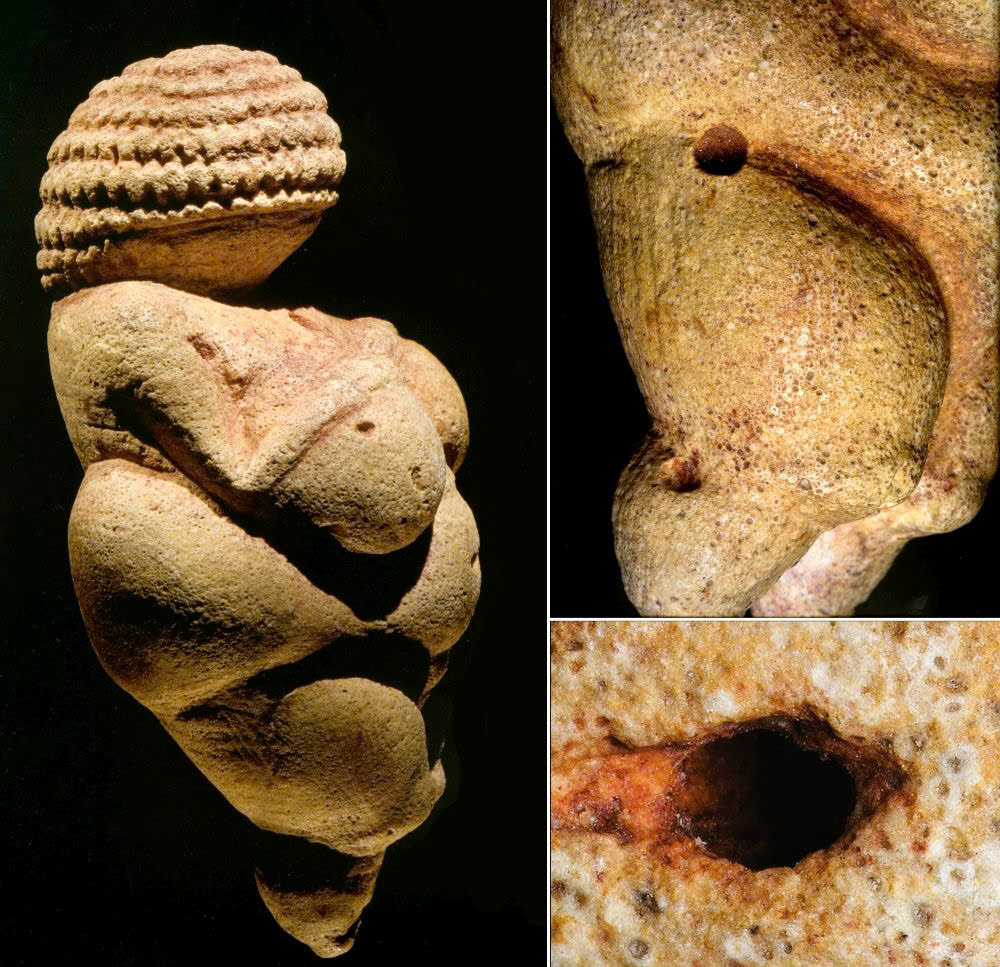In the quaint village of Willendorf, nestled in the heart of Austria, an extraordinary archaeological discovery was made in the early 20th century. Beneath layers of ancient soil, a small yet profoundly significant artifact was unearthed—a limestone figurine now famously known as the Venus of Willendorf. Standing at just 11.1 centimeters tall, this sculpture, with its exaggerated feminine features, has captured the imagination of historians and archaeologists alike. The Venus of Willendorf is more than a mere artifact; it is a window into the beliefs, rituals, and artistic expressions of our distant ancestors, offering a glimpse into a world shrouded in mystery.
The figurine’s unique design immediately sets it apart as a masterpiece of prehistoric art. Carved from oolite limestone, the Venus of Willendorf features an exaggerated representation of the female form. The sculpture highlights pronounced breasts, a rounded stomach, and ample hips, while its legs taper to a narrow point, lacking feet entirely. Slender arms rest delicately atop the chest, further drawing attention to the figurine’s prominent features. The head, devoid of any facial details, is covered with intricate patterns that resemble tightly coiled hair or perhaps a woven cap. Notably, the depiction of the genital area is rendered with remarkable detail, contrasting with the otherwise abstract representation of the body.

One of the most fascinating aspects of the Venus of Willendorf is the material from which it was crafted. Recent scientific analyses have revealed that the limestone used to create the figurine did not originate in the immediate vicinity of Willendorf. Instead, it likely came from northern Italy or possibly even as far as Ukraine. This revelation opens up intriguing possibilities about the figurine’s journey through time and space. It suggests the existence of long-distance trade networks or cultural exchanges in prehistoric times, pointing to a level of connectivity and sophistication that was previously underestimated.
The purpose and significance of the Venus of Willendorf have been the subject of much scholarly debate. Many researchers believe that the figurine served as a symbol of fertility, embodying the life-giving powers of women. The emphasis on body parts associated with reproduction and childbearing suggests that it may have been a talisman or even a representation of a fertility goddess. In Paleolithic societies, where survival depended heavily on successful reproduction and the nurturing of new life, such symbols would have held immense spiritual and cultural value.
Ritualistic uses of the Venus of Willendorf are another area of speculation. Imagine ancient communities gathering around the figurine during important ceremonies. It might have been carried through fields during planting seasons, believed to bless the soil and ensure a fruitful harvest. Alternatively, it could have been a focal point in rituals for women preparing for childbirth, serving as a source of strength and a symbol of fertility and resilience. These imagined scenarios highlight the central role that such artifacts may have played in the spiritual lives of early humans.
Another layer of mystery surrounding the Venus of Willendorf is the discovery of red ochre traces on its surface. Microscopic examinations have revealed that this pigment, often associated with symbolic practices in ancient cultures, was applied to the figurine. Red ochre held profound significance in many prehistoric societies, symbolizing life, death, and rebirth. Its presence on the Venus of Willendorf suggests that the figurine was not merely an artistic creation but also a deeply symbolic object imbued with ritualistic meaning. This connection to broader symbolic practices underscores the figurine’s importance as a cultural and spiritual artifact.
The craftsmanship of the Venus of Willendorf is another testament to the artistic and technical abilities of its creator. Despite its small size, the figurine’s details are meticulously rendered, showcasing the skill and vision of its maker. Advanced technologies like 3D scanning have allowed researchers to study the artifact with unparalleled precision, revealing subtle nuances that might otherwise have gone unnoticed. Each curve, indentation, and detail tells a story of artistic intent and technical prowess, providing insight into the creative capabilities of prehistoric humans.
As modern technology continues to shed light on the Venus of Willendorf, its significance only grows. The figurine is not just an isolated artifact but a part of a larger narrative about human culture, art, and spirituality. It serves as a reminder of the universal human desire to understand and celebrate the mysteries of life. The Venus of Willendorf stands as a testament to the enduring power of art to communicate across millennia, connecting us to the hopes, fears, and beliefs of those who came before us.
The figurine’s enigmatic features and the mysteries surrounding its origin and purpose ensure that it remains a focal point of scholarly inquiry. As we piece together its story, we gain not only a deeper understanding of prehistoric societies but also a greater appreciation for the creativity and ingenuity of our ancestors. The Venus of Willendorf invites us to reflect on the shared humanity that unites us across time, reminding us of the timeless themes of fertility, survival, and the search for meaning in an ever-changing world.
In conclusion, the Venus of Willendorf is far more than a simple figurine. It is a profound symbol of human creativity, spirituality, and connection. From its meticulously carved features to the traces of red ochre that hint at its ritualistic use, every aspect of the Venus of Willendorf tells a story that resonates across ages. This small limestone artifact holds immense significance, not only as a work of art but also as a cultural touchstone that bridges the gap between the ancient past and our present understanding of human history. As we continue to explore its mysteries, the Venus of Willendorf remains a beacon of inspiration, offering valuable insights into the lives, beliefs, and artistic achievements of our prehistoric ancestors.





